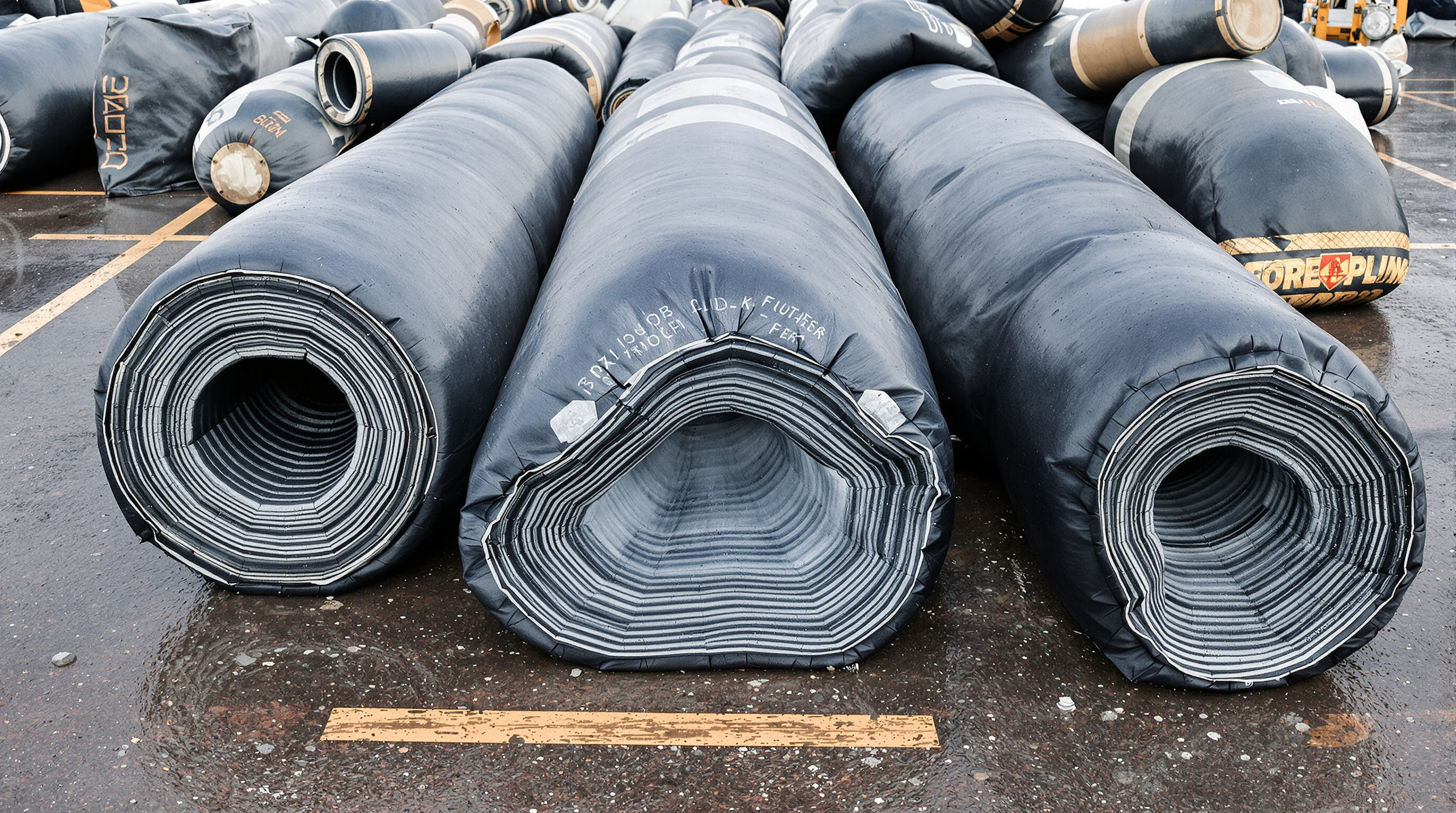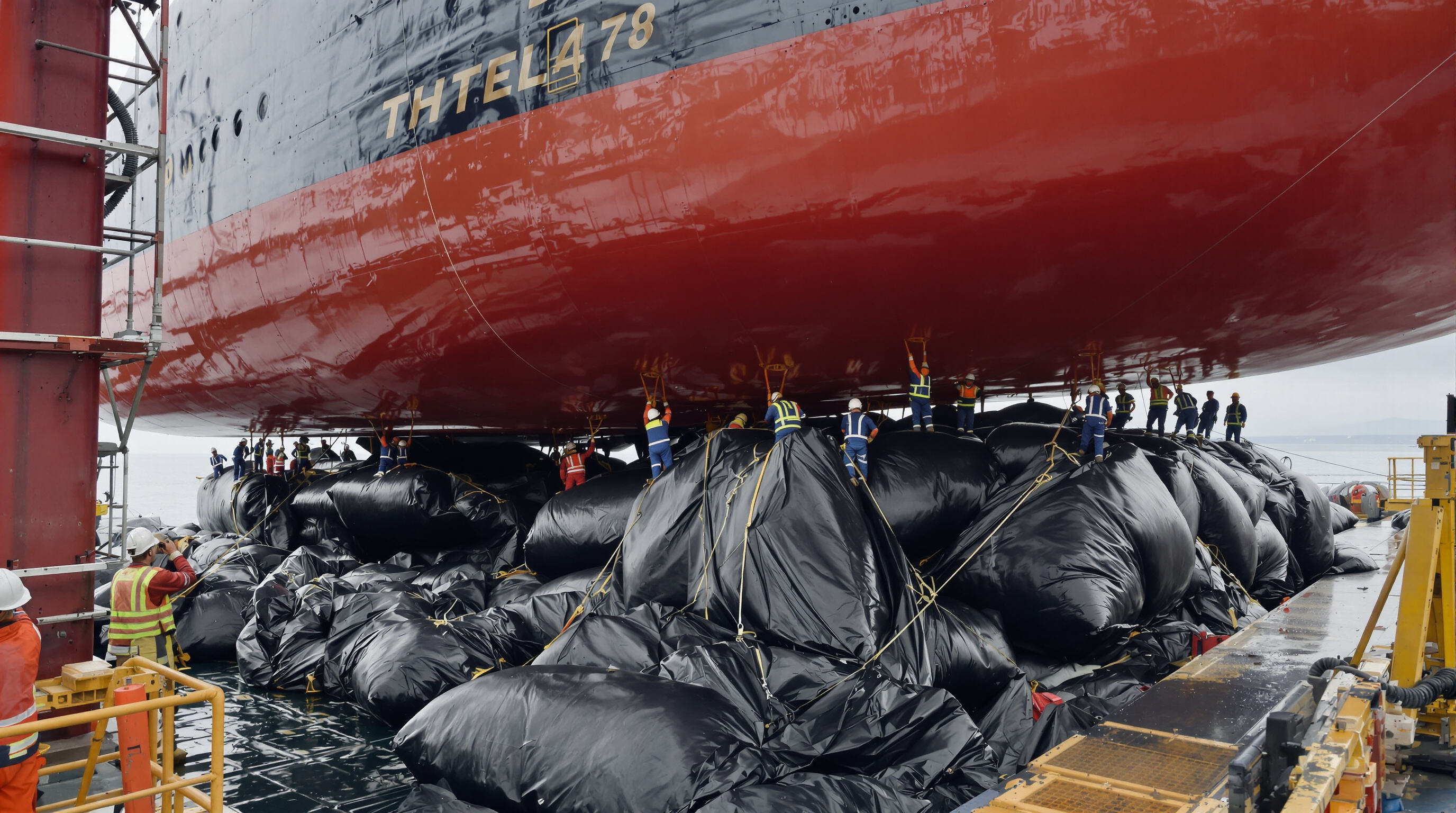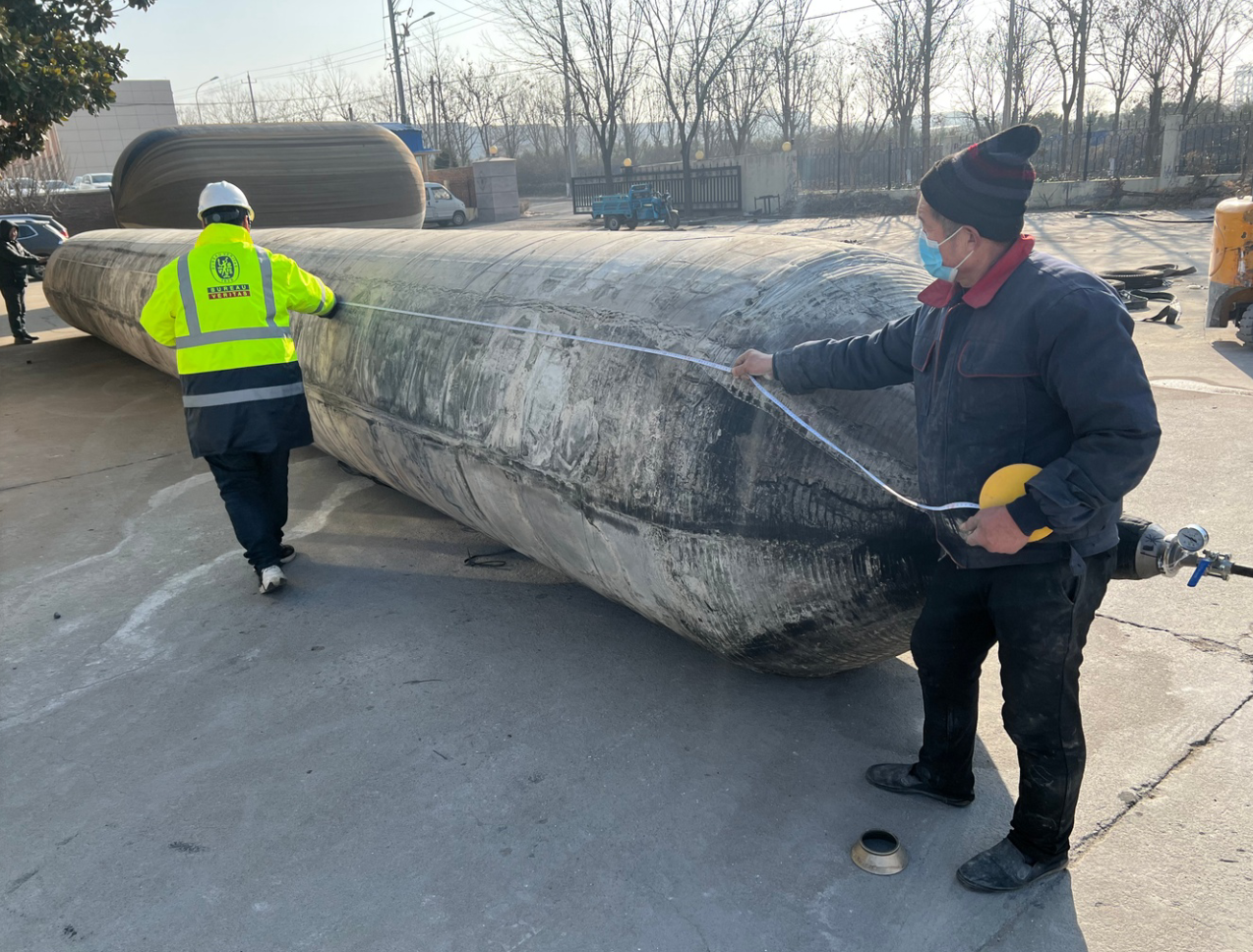Core Principles of Rubber Airbag Use in Ship Launching and Marine Salvage
The Shared Mechanics of Ship Launching and Salvage Operations Using Rubber Airbags
The physics behind rubber airbags work pretty much the same whether they're used for launching ships or doing marine salvage operations. These devices rely on controlled buoyancy created by those tough rubber membranes. When launching vessels, placing airbags underneath the hull can cut down ground friction significantly around 68% according to research published in the Journal of Marine Technology back in 2020. This makes it much easier to move massive ships from dry docks into open waters. For salvage work, the principle stays the same but with different results. The airbags push out seawater to create lift forces that can exceed 250 tons each unit. Built from between six to eight layers of synthetic tire cord fabric bonded together with rubber during vulcanization, these robust structures hold up remarkably well even when subjected to immense pressures in both scenarios.
Key Performance Requirements for Rubber Airbags in Dual Applications
Dual-use airbags must meet three core criteria:
- Pressure resistance: Sustain 0.08–0.12 MPa without deformation
- Environmental durability: Resist saltwater, UV exposure, and abrasion
- Operational flexibility: Function reliably between -4°F and 140°F (-20°C to 60°C)
Advanced rubber compounding achieves tear strength above 45 kN/m while retaining 92% elasticity after 500 compression cycles (Naval Architecture Report, 2022). ISO 14409-certified models lose less than 3% air volume per 24 hours, ensuring consistent performance during prolonged salvage operations.
How Buoyancy and Load Distribution Determine Airbag Suitability
Buoyancy efficiency depends on precise volume-to-displacement ratios. For a standard 5,000-ton vessel:
| Parameter | Launching Requirement | Salvage Requirement |
|---|---|---|
| Individual buoyancy | 200–300 tons | 150–250 tons |
| Contact surface | 40–60% hull length | 70–85% hull length |
| Inflation pressure | 0.06–0.08 MPa | 0.10–0.12 MPa |
Naval engineers recommend a 70/30 fore-aft load distribution for vessels under 55,000 DWT to prevent structural deformation while maintaining control during launch and recovery, as demonstrated in marine engineering applications.
Critical Technical Specifications for Multi-Use Rubber Airbags

Material composition: Rubber construction with synthetic tire cord layers
The multi purpose airbags are made from hydrogenated nitrile rubber mixed with reinforced synthetic tire cords to stand up against chemicals and maintain their shape. Tests show that HNBR keeps about 92 percent of its strength even after sitting in seawater for over 600 days straight. And those woven tire cord layers make them much tougher too they can handle bursts better than regular single material bags by around 40 percent according to research published in Polymers back in 2021. What makes these airbags so special is how flexible they stay despite all this reinforcement. They can stretch up to 35 percent before breaking which means they work great whether being deployed during launches or used for recovery operations where pressure control matters most.
Pressure resistance and durability benchmarks for marine environments
Marine-grade airbags must withstand 10 MPa internal pressure with ¢0.5% deformation per cycle. Top manufacturers use triple-layer vulcanization to meet performance thresholds:
| Parameter | Ship Launching | Marine Salvage |
|---|---|---|
| UV Resistance (hours) | 2,000 | 1,500 |
| Abrasion Loss (mm³) | 80 | 120 |
| Operating Temp Range | -30°C to 60°C | -15°C to 45°C |
These standards ensure 5–7 years of reliable service across tidal and submerged conditions.
Buoyancy calculations and volume-to-load ratios in real-world scenarios
Lift capacity is determined by the formula B = V × Í × g, where V is airbag volume, Í is seawater density, and g is gravity. For a 3-meter diameter airbag supporting 1,200 tons:
- Required volume: 1,100 m³
- Safety margin: 25% above calculated load
- Inflation pressure: 0.25–0.35 MPa
Field data from Southeast Asian shipyards shows 98% correlation between theoretical models and actual performance when using certified airbags.
Standardized testing protocols for multi-use rubber airbags
ISO 22762-3 mandates six-stage validation:
- Accelerated aging (70°C, 30% salinity, 500 hrs)
- Cyclic pressure testing (10,000 cycles at 8 MPa)
- Tear propagation resistance (ASTM D624)
- Cold flex cracking (ASTM D430)
- Seawater immersion (1,000 hrs with weight measurement)
- Full-scale field simulation
Third-party labs reported an 89% compliance rate among manufacturers in 2023, with 63% of failures linked to seam integrity and 28% to valve retention systems.
Comparative Analysis of Nanhai ES, S, and P Series for Dual Applications
Nanhai ES series: Performance in ship launching and adaptability to salvage
When it comes to launching ships, the ES series really stands out because of those reinforced metal ends that spread weight evenly across the hull, keeping stress variations below 15%. What's interesting is how these same structural advantages come into play during salvage operations too. The system maintains pressure stability at around 85% for three full days, which makes all the difference when trying to get a sunken vessel back on the surface. The whole thing has this clever hybrid construction that handles tearing forces pretty well actually (about 14 kN per square millimeter) while still offering good lift capabilities relative to displacement weight, sitting somewhere around a 1 to 2.3 ratio. Pretty impressive engineering if you ask me.
S-series airbags: Flexibility and strength balance for launching and light salvage
The S-series airbags come with triple strand synthetic tire cords which gives them around 22 percent better flex cycle endurance compared to what's standard in the industry. This makes these airbags really good for those situations where ships need to be launched repeatedly from shipyards. When it comes to salvage operations, these airbags can handle pressures between 300 and 400 kN per square meter, so they work well even when deployed beneath partially submerged hulls. However, there is a catch - they're only suitable for vessels weighing less than 5,000 deadweight tons. Testing in real world conditions has shown that at 85% of their maximum load capacity, these airbags deform by no more than 3%, even while being inflated at the same time as other units.
P-series airbags: High-capacity solutions optimized for vessel salvage
The P-series units are designed specifically for tough salvage work, with those dual-strand cord setups giving them around 18% better pressure output, reaching as high as 550 kN per square meter. These models can handle launches alright, but they do struggle with tight curves because their bend radius is about 32% smaller compared to the S-series versions, which makes them less efficient when working on ships with complex hull shapes. When fully submerged, these units manage impressive buoyancy to load ratios at about 1 to 3.1. The outer layers meet ISO 2230:2021 standards and resist wear pretty well, something that becomes really important during extended underwater operations where equipment gets put through its paces.
Cross-application efficiency: Which Nanhai model best serves both roles?
A 2023 study of 47 marine projects identified the ES series as the most versatile dual-use option:
| Metric | ES-series | S-series | P-series |
|---|---|---|---|
| Avg. Launch Cycles | 14.7 | 16.2 | 9.1 |
| Salvage Success Rate | 92% | 78% | 95% |
| Cross-Use ROI | 1:3.8 | 1:2.9 | 1:1.7 |
With integrated pressure monitoring ports and adaptive cord geometry, ES-series airbags meet 83% of combined launch and salvage requirements—significantly higher than the 67% for S-series and 41% for P-series. Manufacturers recommend ES models for projects requiring ¥60% cross-functional utilization.
Best Practices in Deployment and Operational Execution

Step-by-Step Deployment Process for Ship Launching Using Rubber Airbags
Successful deployment follows three key phases:
- Pre-inflation checks – Confirm material integrity and alignment with the vessel‘s center of gravity
- Staggered inflation – Gradually pressurize to 80–85% capacity using synchronized pumps
- Controlled roll-off – Maintain 0.8–1.2 MPa pressure differentials between adjacent airbags
A 2023 analysis of 47 shipyard operations found standardized protocols reduced launch failures by 62% compared to ad hoc methods.
Strategic Placement of Marine Salvage Rubber Airbags Under Sunken Vessels
Optimal placement balances lift efficiency and structural safety:
| Factor | Salvage Requirement | Airbag Response Strategy |
|---|---|---|
| Seabed composition | Mud/sand vs. rocky surfaces | Adjust base stabilization |
| Hull deformation | Symmetric vs. skewed damage | Triple-layer placement zones |
| Water depth | <15m vs. >15m | Buoyancy compensation ratios |
The International Maritime Salvage Union recommends placing 25–35% of total airbags near bow and stern weak points to prevent hull fractures during refloating.
Synchronization of Inflation and Control Systems During Refloating Operations
Modern operations use PLC-controlled manifolds with ultrasonic thickness gauges to maintain ¢5% pressure variance across airbags. Data shows synchronized systems achieve 92% faster surfacing in tidal environments while reducing stress fatigue by 78% (Marine Technology Society, 2024). Key failsafes include automated pressure bleed valves and AI-driven load redistribution to respond to seabed shifts.
Real-World Case Studies and Industry Trends in Dual-Use Rubber Airbags
Refloating a Grounded Cargo Ship Using Ship Launching Airbags in Southeast Asia
Back in 2023, salvage crews managed to get a 12,000 deadweight ton cargo ship back into the water after it ran aground on some delicate coral reefs. They used those standard ship launching airbags everyone knows about. The team placed 28 of these airbags along the left side of the ship and timed their inflation carefully with the tides coming in and out. This allowed them to slowly increase the ship's buoyancy without causing further damage. What really made the difference was keeping an eye on pressure spikes that went over 0.8 MPa. That number turned out to be super important, something the folks at the Marine Salvage Materials Report pointed out in their 2024 edition as a key indicator for successful operations like this one.
Dual-Role Application: Launching a New Vessel and Recovering a Capsized Ferry
In the Philippines, a local shipyard put those same airbags to work for two different purposes recently. First they helped launch a massive 90 meter RoPAX ferry, then months later came back to rescue the ship's overturned sibling from the ocean floor. What really impressed everyone was how well the synthetic tire cord reinforcement held up through all this action. The material had between six and eight layers, which proved strong enough not only for launching something weighing over 3,200 tons but also surviving weeks of being dragged across rough seabed sediment during the salvage effort. After checking everything out afterwards, engineers found that the materials showed less than 3 percent wear overall. This means these airbags can actually serve multiple functions as long as we keep the weight distribution within safe limits, specifically when the load doesn't exceed about 75 percent of what the system is rated for.
Lessons Learned From Failed Deployments in Marine Salvage Airbag Operations
- Airbags rated for 150-ton launches ruptured at 80 tons due to uneven seabed contact
- Uncoated rubber degraded from saltwater infiltration during extended deployment
- Lack of real-time monitoring delayed leak detection
These issues prompted updates to ISO 23904-2023, mandating salvage-specific reinforcement and corrosion-resistant coatings.
Advancements in Rubber Airbag Durability and Smart Monitoring Systems
Recent models feature 2 mm chlorobutyl rubber liners and integrated IoT strain sensors, extending operational life by 40% in saltwater. Trials indicate these sensors detect microtears 8–12 hours before visible failure, reducing emergency risks by 67% (Maritime Safety Council, 2023). Manufacturers now offer modular designs that allow retrofitting legacy airbags with smart monitoring capabilities.
Frequently Asked Questions (FAQs)
What are the key uses of rubber airbags in maritime operations?
Rubber airbags are primarily used for ship launching and marine salvage operations. In ship launching, they reduce ground friction, allowing for smooth transitions from dry docks to water. In marine salvage, they help lift sunken vessels by displacing seawater.
How do rubber airbags withstand harsh marine environments?
Advanced rubber compounding, including the use of materials like hydrogenated nitrile rubber and synthetic tire cords, allows airbags to resist pressure, saltwater, UV exposure, and abrasion, ensuring durability.
What are the benefits of using multi-use rubber airbags?
Multi-use airbags offer the flexibility to be used in both launching new vessels and recovering submerged ships. They are engineered to handle diverse loads and conditions while maintaining integrity and performance.
Which Nanhai series is most versatile for dual applications?
The Nanhai ES series is identified as the most versatile for dual applications, meeting 83% of combined launch and salvage requirements, which is significantly higher than other models.
What advancements have been made in rubber airbag technology?
Recent advancements include the integration of IoT strain sensors for early microtear detection, which extends operational life and reduces risks. Modern designs also allow for retrofitting of old models.
Table of Contents
- Core Principles of Rubber Airbag Use in Ship Launching and Marine Salvage
- Critical Technical Specifications for Multi-Use Rubber Airbags
-
Comparative Analysis of Nanhai ES, S, and P Series for Dual Applications
- Nanhai ES series: Performance in ship launching and adaptability to salvage
- S-series airbags: Flexibility and strength balance for launching and light salvage
- P-series airbags: High-capacity solutions optimized for vessel salvage
- Cross-application efficiency: Which Nanhai model best serves both roles?
- Best Practices in Deployment and Operational Execution
-
Real-World Case Studies and Industry Trends in Dual-Use Rubber Airbags
- Refloating a Grounded Cargo Ship Using Ship Launching Airbags in Southeast Asia
- Dual-Role Application: Launching a New Vessel and Recovering a Capsized Ferry
- Lessons Learned From Failed Deployments in Marine Salvage Airbag Operations
- Advancements in Rubber Airbag Durability and Smart Monitoring Systems
-
Frequently Asked Questions (FAQs)
- What are the key uses of rubber airbags in maritime operations?
- How do rubber airbags withstand harsh marine environments?
- What are the benefits of using multi-use rubber airbags?
- Which Nanhai series is most versatile for dual applications?
- What advancements have been made in rubber airbag technology?


